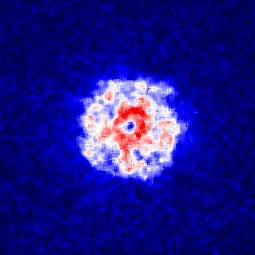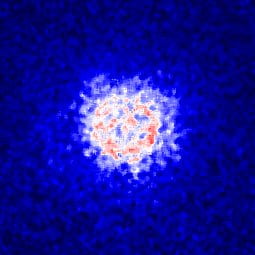We have just shown that we can clearly distinguish between a ring with a persistent current flowing around it and a stationary superfluid (molecular BEC of Li-6). The basic procedure is to relax the radial confinement of the atoms in the ring trap in a prescribed way, then suddenly release the atoms completely and allow the cloud to expand for several milliseconds. If there is (quantized) circulation around the ring then we see a hole in the middle of the expanded cloud, because of the phase singularity that must be present in the superfluid. 
For comparison, if there is no circulation in the superfluid, then the expanded cloud looks like this:
Detecting the vortex signature in this expanding fermionic superfluid is a little more challenging to do well than in previous experiments with atomic Bose condensates (of e.g. rubidium or sodium). The cloud expands quite rapidly even for small numbers of atoms, because the momentum of the atoms is comparatively high due to degeneracy pressure. We’ve got a handle on this, though and it’s clearly not going to be an obstacle to the experiments we have planned. The images above mostly look noisy due to photon shot noise, and we expect to be able to do much better than this soon.

